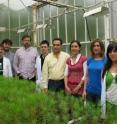Measuring the stress of forested areas
Plants undergo stress because of lack of water, due to the heat or the cold or to excess of light. A research team from the University of the Basque Country have analysed the substances that are triggered in plants to protect themselves, with the goal of choosing the species that is best suited to the environment during reforestation under adverse environmental conditions. Droughts, extreme temperatures, contamination, and so on – all are harmful to plants. On occasions, the damage is caused by humans. For example, as a consequence of cutting down trees, plants used to shady conditions may be exposed to an excess of light. However, in most cases it is nature itself that causes the stress. In spring, plants have sufficient average humidity and temperatures, i.e. what scientists deem 'optimum conditions'. But in winter they have to withstand considerable cold and in summer, on the other hand, high temperatures and droughts: adverse environmental factors that generate stress situations. Thus, in winter and in summer, the light which under normal conditions would be a source of energy becomes excessive, given that the metabolism of the plants under these conditions is not able to assimilate it. This process is known as photo-oxidative stress.
Some plants are incapable of withstanding this stress – unable to dissipate the excess energy, generating a chain reaction by which they deteriorate and die. Other species, on the other hand, undergo processes of acclimatising themselves to the new situation and trigger chemical compounds that act to protect them. These species are the object of interest of a research team from the Department of Plant Biology and Ecology at the Faculty of Science and Technology of the University of the Basque Country (UPV/EHU). The members of this team – called EKOFISKO and led by Dr. Txema Becerril – are studying the plants' defence mechanisms in order to predict damage before it is produced. They measure the photo-protector substances created by the plants and analyse their behaviour, using them as biosensors of photo-oxidative stress.
Amongst all these plants, they have been studying trees and other forest species, given that they are long-cycle species and it is important that they acclimatize correctly to the environment before reforestation is embarked upon. The autochthonous species of the Autonomous Community of the Basque Country (CAPV), especially the southern part thereof, being where the two climatic regions - the Atlantic and the Mediterranean – meet, would be the first to suffer the consequences of climate change. The study mainly involves species with ecological, economic or landscape interest, and analyses both the deciduous species and the perennial varieties; particularly the latter as they withstand the cold winter temperatures without shedding their leaves.
On the trail of the box tree
The box is a model species and a good example for analysing the defence mechanisms of plants: it is capable of withstanding quite different environments (both dry and sunny climes as well as damp and shaded conditions), thanks to its resistance and adaptability. When it is under stress, the leaves go red, as other species do in autumn, but its peculiarity is that it is able to convert its chromoplasts (where the red pigments accumulate) into chloroplasts (with green pigments) and once again capture energy when the stress conditions disappear.
In order to measure the biomarkers of photo-oxidative stress the research team also simulated the winter or summer conditions in the greenhouse and in the growing rooms at the Faculty of Science and Technology, i.e. they artificially induced in the plants the conditions which they would have to be subjected. This makes it possible to isolate each one of the stress agents and to study its consequences, leaving aside the rest of the variables found in nature.
According to what the research team at the UPV/EHU have shown, the secret to being the most adaptable species lies in accumulating antioxidants, such as vitamin E and special carotenoids (carotenes and xantophylls); precisely the substances that provide colour to plants. On receiving too much light, the VAZ cycle is triggered and the balance between three xantophylls (corresponding to these 3 initials) is altered so that the excess energy does not harm the plants. The human body, for example, is not capable of creating these highly important substances itself and it has to ingest vegetables in order to obtain antioxidants (from plants). Besides studying the VAZ cycle, Mr Txema Becerril's team has contributed to the discovery of a new cycle (the lutein epoxide cycle), present in many forest species such as beech, laurel, holm oak or oak and the team is currently studying what exactly is its protective function.
Source: Elhuyar Fundazioa
Other sources
- Measuring Stress In Plants To Select Best Species For Reforestationfrom Science DailyTue, 22 Jul 2008, 15:07:27 UTC
